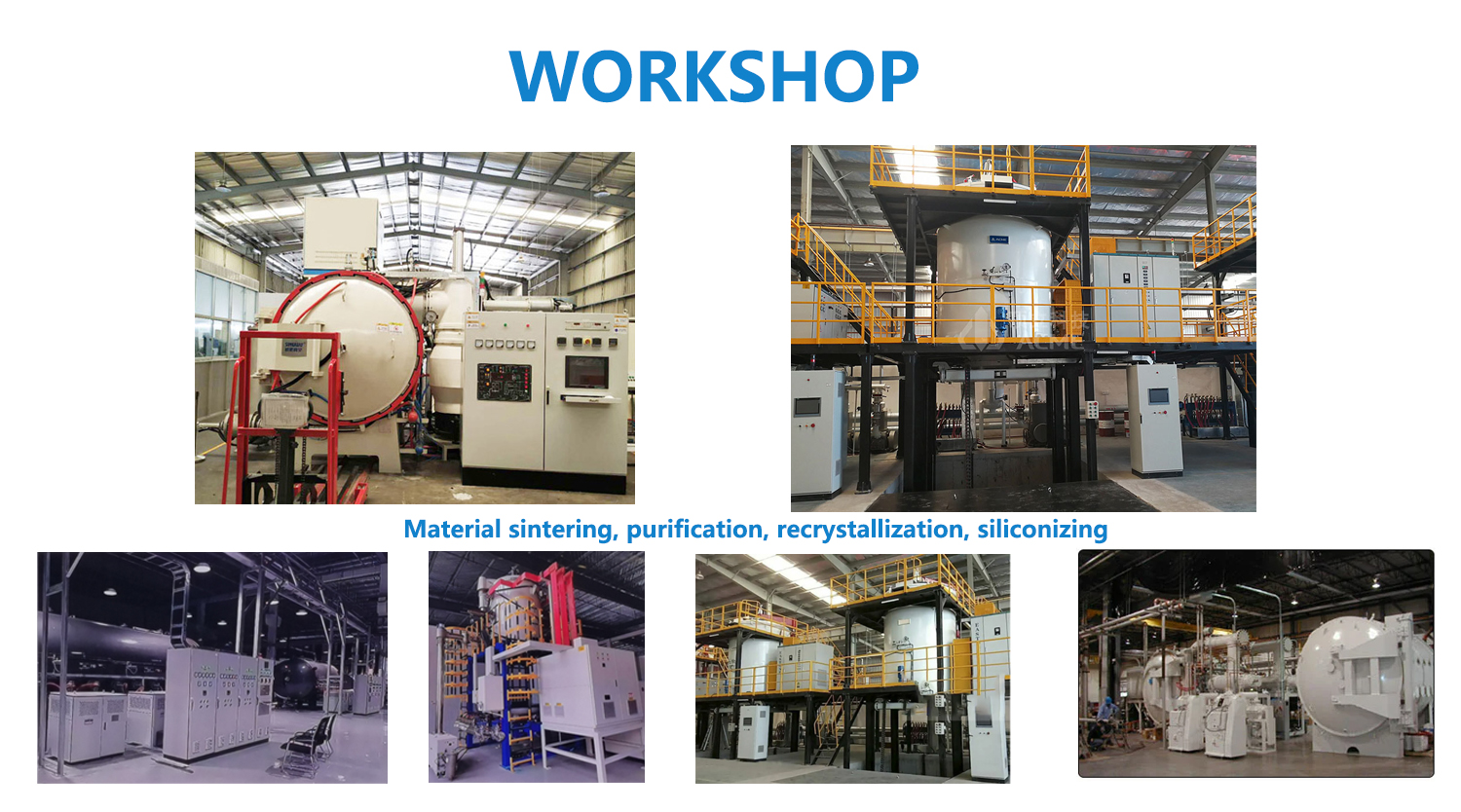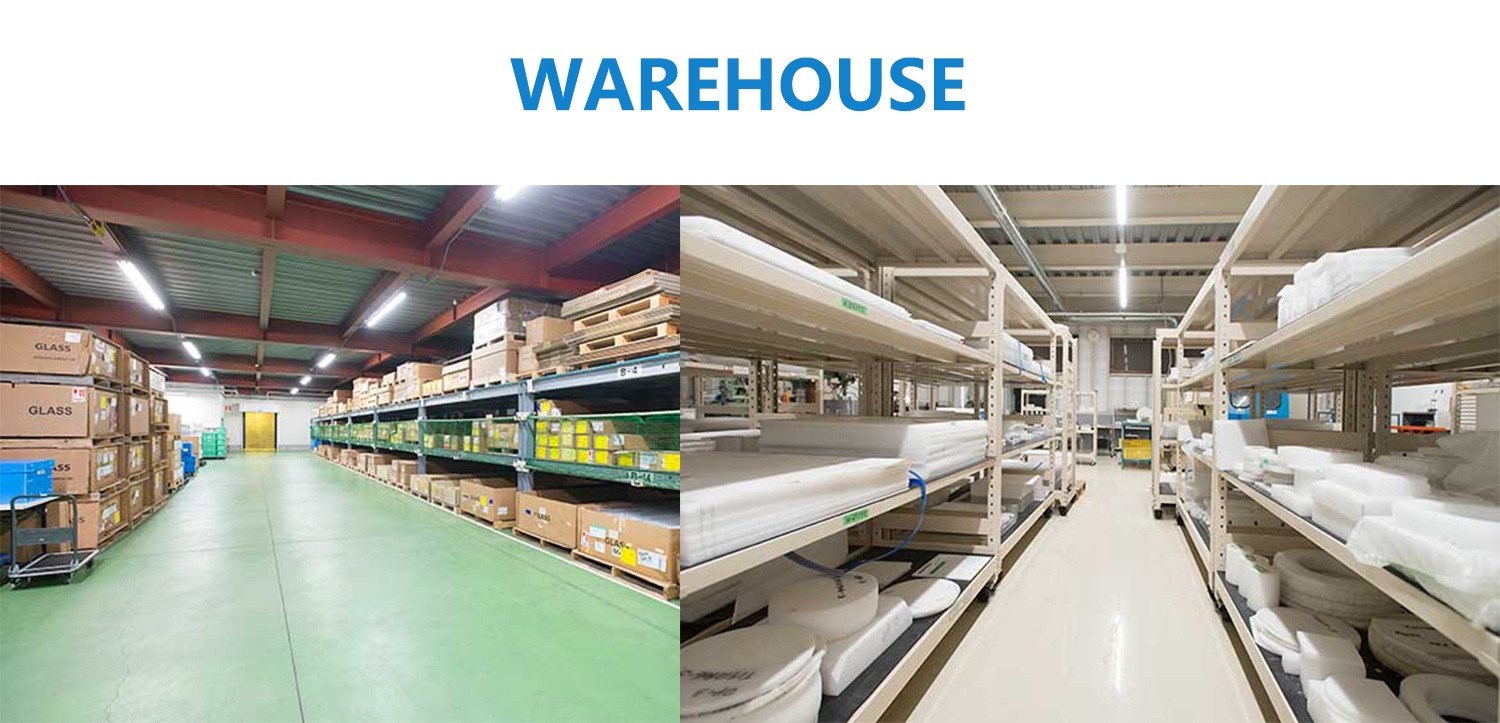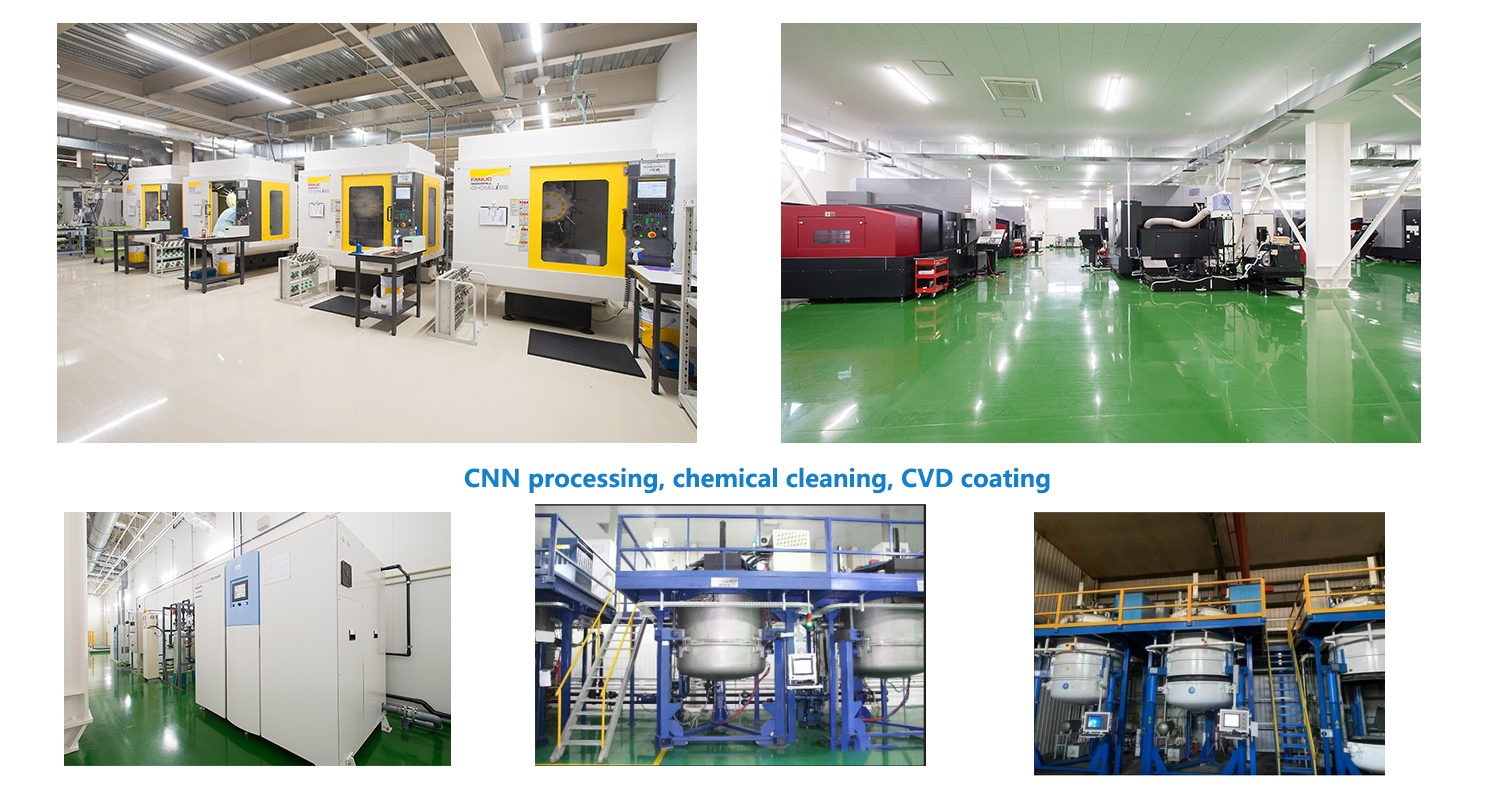
SiCのコーティングのキャリアは半導体の製造を変えました 高精度なプロセスにおける重要な課題に対応 堅牢な SiCコーティング 保障して下さい 例外的な熱安定性および汚染の抵抗, 要求の厳しいアプリケーションのために不可欠にする. お問い合わせ SiC coating carriers エッチングの効率および精密を高めて下さい ふりがな 粒子の発生を削減し、きれいな表面を作る 高純度材料の蒸着のため。 耐久性は維持の必要性を最小にし、部品寿命を延ばし、コストを削減します。 のような高度の特性を使って 酸化および化学腐食への抵抗、SiCのコーティングのキャリアは極度な環境の信頼できる性能を保障します従来の材料を抜きます。 この革新は一貫した結果、運転の効率および質をで支えます semiconductor production, particularly through the use of インフォメーション SiCコーティング テクニック.
要点
- SiC coating carriers 熱の下で強い滞在し、汚染を避けることによって半導体を作るのを助けて下さい.
- 彼らは熱を均等に広め、それは重要です 良い半導体デバイスを作る.
- SiCのコーティングのキャリアは純粋な物質的な層のためにきれいに表面を保ちます形成からの粒子を停止します.
- 彼らは長い間持続し、より少ない固定を必要とし、お金および時間を節約します.
- これらのキャリアは、非常にホットな場所、厳しい半導体タスクに最適です.
- SiCコーティングキャリアを使用することで、作業速度を削減し、作業速度を向上させることで、時間をかけてコストを節約できます.
- SiCのコーティングのキャリアはエッチングをより正確、より多くの半導体を作り出すのを助けます.
- 車の電子機器やグリーンエネルギーシステムなど、多くの用途で活躍しています.
SiCコーティングキャリアの理解
SiCコーティングキャリアの構成と特性
SiC coating carriers are crafted using advanced chemical vapor deposition (CVD) techniques. This process deposits high-purity silicon carbide molecules onto materials like graphite, creating a robust protective layer. The resulting carriers exhibit exceptional physical and chemical properties that make them ideal for semiconductor manufacturing.
キープロパティには、 high thermal conductivityウェーハ処理中に一貫した温度制御を保証します。 この機能は、均一なエピタキシャル層を形成するために不可欠です。 SiCのコーティングのキャリアはまた酸化および化学腐食に抵抗し、粗い環境の完全性を維持します。 耐久性は寿命を延ばし、頻繁な交換の必要性を減らします.
| プロパティ | 説明 |
|---|---|
| High Thermal Conductivity | 高温プロセス中にウェーハの品質を維持するために重要な効率的な熱管理を確保します. |
| Temperature Resistance | 極端な温度に耐えるため、半導体プロセスの熱管理に最適です. |
| 化学成分 | 化学反応や腐食に対する堅牢な障壁として機能し、キャリアが過酷な化学物質に影響されないことを保証します. |
| Durability | 摩耗、酸化および化学腐食への抵抗を高め、それらを精密企業のために信頼できるようにします. |
これらの特性により、SiCコーティングキャリアは要求の厳しい半導体アプリケーションで確実に実行できます.
Role in Semiconductor Manufacturing
SiC coating carriers play a 半導体製造における重要な役割 工程の効率および信頼性を高めることによって。 熱安定性は急速な熱処理(RTP)および急速な熱アニール(RTA)のような高精度操作のために必要である最適処理温度を、保障します。 また、ウェーハの取り扱いや化学蒸着(CVD)時の汚染を防止し、高純度を維持しています.
Their 化学抵抗 加工材料との反応のリスクを低減し、ウェーハの完全性を維持します。 また、SiCコーティングキャリアは表面粗さと気孔率を最小化し、材料の堆積のためのクリーナー環境を作成します。 この機能は均一フィルムの成長のために精密な温度制御が必要である表軸プロセスのために特に有利です。 これらの役割を担って、SiCコーティングキャリアは一貫した高品質な半導体製造に貢献します.
従来のキャリアとの比較
SiCコーティングキャリアは、いくつかの重要な領域で伝統的なキャリアを外しています。 水晶または光沢が無いグラファイトのような従来の材料は、しばしば半導体製造の極端な条件に耐えるのに苦労します。 対照的に、SiCによって塗られるグラファイトのキャリアは炭化ケイ素の保護特性とグラファイトのライト級選手強さを結合します。 高温および化学的に積極的な環境に理想的な組み合わせです.
- SiCのコーティングのキャリアは性能を妥協しないで急速な温度の変更に耐えることを可能にする優秀な熱安定性を提供します.
- 機械的強度と耐摩耗性が大幅に寿命を延ばし、メンテナンスコストを削減します.
- SiCコーティングの耐薬品性は、従来の材料とは異なり、腐食性ガスや過酷な化学物質によってキャリアが影響されないことを保証します.
これらの利点はSiCのコーティングのキャリアを現代半導体プロセスのためのより有効で、耐久の選択させます.
SiCコーティングキャリアの利点
耐久性と寿命の向上
SiCコーティングキャリアは、優れた耐久性を発揮し、半導体製造に確実な選択肢を発揮します。 軽量のグラファイトの中心および炭化ケイ素のコーティングの組合せは摩耗、酸化および化学腐食への抵抗を高めます。 この堅牢な構造により、キャリアは厳しい条件下でもその完全性を維持します.
- SiCの層は熱衝撃および機械圧力からグラファイトの基質を保護します、長期信頼性を保障します.
- SiCのコーティングは頻繁に取り替えのための必要性を減らすグラファイト材料の耐摩耗性を著しく改善する示します.
- 炭化ケイ素のコーティング キャリアの寿命を延ばします 高温での酸化・劣化を防止します.
これらはメーカーのダウンタイムと運用コストを削減し、SiCコーティングキャリアを費用対効果の高いソリューションにします。 半導体製造における効率性を維持するためには、長期にわたって一貫して実行する能力が重要である.
優れた熱安定性
SiCのコーティングのキャリアは優秀な熱安定性による高温環境で積みます。 高い熱伝導性 効率的な熱管理を確保、化学薬品の蒸気の沈殿物(CVD)のようなプロセスの間にウエファーの質を維持するために必要です.
- これらのキャリアは、半導体製造における熱管理に理想的な極端な温度に耐えることができます.
- SiCのコーティングは急速な温度の変動の間に酸化および変形、抵抗します.
- 耐久性は、厳しい環境で信頼性の高い性能を確保し、生産中のエラーの危険性を減らします.
半導体ウェーハの精密な加工と機能制御をサポートし、チップ製造の全体的な効率性を高めます.
汚染および腐食の抵抗
SiCコーティングキャリアは、汚染や浸食に対する優れた耐性を提供し、半導体プロセスのクリーンで安定したプラットフォームを保証します。 炭化ケイ素の層は化学反応に対して障壁として機能し、酸化および腐食からグラファイトの中心を保護します.
- 硬質SiCコーティングにより、粒子の発生を最小限に抑え、高純度材料の堆積をスムーズにする.
- その機械的強度は、キャリアを摩耗から保護し、過酷な環境での長期信頼性を保証します.
- SiC層は、変形や汚染リスクを軽減し、極端な温度下で構造的完全性を維持します.
これらのプロパティは、エッチングや蒸着などのプロセスに欠かせないSiCコーティングキャリアを作る。精度と清潔さが重要である。 汚染や浸食を減らすことで、半導体製造の品質と一貫性を高めます.
長期使用におけるコスト効率
SiCのコーティングのキャリアは半導体の製造の従来の代わり上の重要な費用利点を提供します。 独自の特性により、メンテナンスの必要性や運用の中断を軽減し、 費用効果が大きい解決 長期使用のため。 メーカーは、厳しい条件に耐える能力から恩恵を受けており、要求プロセス中に摩耗と涙を最小限に抑えます.
SiCコーティングの耐久性が高いため、キャリアは極端な温度や化学的暴露下でも構造的完全性を維持します。 この耐久性は、交換の頻度を減らし、メーカーのお金を節約します。 また、堅牢な炭化ケイ素層は、酸化および機械的ストレスからグラファイトコアを保護し、さらにキャリアの寿命を延ばします.
SiCコーティングキャリアへの投資は、 かなりの長期節約. . 優秀な熱管理機能は高温操作の間にエネルギー消費を減らすプロセス効率を高めます。 この効率は、メーカーの運用コストを削減します.
いくつかの要因は、SiCコーティングキャリアのコスト効率に貢献します
- それらは腐食および汚染への抵抗によるより少ない頻繁な維持を要求します.
- 急速な温度変化に耐える能力は装置の故障によって引き起こされるダウンタイムを最小にします.
- それらの延長寿命は頻繁に取り替えのための必要性を減らします、全面的な材料費を下げます.
メーカーも体験 increased productivity siCのコーティングのキャリアを使って。 過酷な環境での信頼性は、無停電の操作を保証します。これにより、一貫した生産スケジュールを維持できます。 運用中断を減らすことで、メーカーはリソースを最適化し、より高い出力レベルを達成することができます.
SiCコーティングキャリアにおける初期投資は従来の選択肢よりも高くなります。 しかし、その長期的な利点は、前方コストを上回ります。 時間の経過とともに、メンテナンス費の削減、寿命の延伸、生産性向上によりコストを大幅に削減。 これらの利点はSiCのコーティングのキャリアを現代半導体の製造のための必要な選択させます.
Applications in Semiconductor Manufacturing

ウェーハ処理・処理
SiCのコーティングのキャリアはウエファーの処理でpivotal役割を担います 半導体製造における取扱い これらのキャリアは高温プロセスの間にウエハに安定したプラットホームを提供し、均一熱配分を保障し、熱圧力を最小にします。 炭化ケイ素のコーティングは熱安定性を高めます、キャリアが構造の完全性を妥協しないで急速な温度の変動に抗することを可能にします。 この機能により、信頼性の高い半導体デバイスの製造に不可欠である一貫したウェーハ品質を保証します.
急速な熱処理(RTP)および急速な熱アニール(RTA)のようなプロセス、SiCのコーティングのキャリアはさまざまな熱条件の下で安定性を維持します。 重要な段階の変形や汚染を防止し、高品質な半導体チップの生産をサポートします。 クリーンで管理された環境を提供することで、現代の半導体製造に必要な精度と信頼性に貢献します.
High-Temperature Operations
SiCのコーティングのキャリアは高温操作で、要求する環境の従来の材料をoutperformingます。 独自の特性により、極端な熱安定性と耐久性を必要とするプロセスに不可欠です.
- 熱安定性: SiCのコーティングは熱衝撃に優秀な抵抗を提供します、急速な温度変化の下で構造の完全性を維持して下さい.
- Mechanical Strength: : : グラファイトの強度とSiCの硬度の組み合わせにより、運用上のストレスに対する耐久性が確保されます.
- Chemical Resistance: : : SiCの層は粗い環境で重要な酸化および腐食からグラファイトの中心を保護します.
SiCコーティングキャリアは、化学蒸気蒸着(CVD)やプラズマ強化化学蒸気蒸着(PECVD)などの高温プロセスで確実に実行できます。 極端な条件に耐える能力 装置の故障によるダウンタイムを最小化 または取り替えは、大量生産周期の間に中断されていない生産を保障します.
エッチングおよび蒸着プロセス
SiCコーティングキャリアは、半導体製造におけるエッチングおよび蒸着プロセスに不可欠です。 炭化ケイ素の層は化学反応に対して強い障壁として機能し、酸化および腐食からグラファイトの中心を保護します。 この保護により、キャリアは、化学的に積極的な環境でも構造的完全性を維持します.
硬質SiCコーティングにより、粒子の発生を最小限に抑え、高純度の材料蒸着に滑らかなきれいな表面を作り出します。 このクレンジングは、精密と均一性がパラマウントされるエピタキシャル成長のようなプロセスにとって重要です。 汚染リスクを軽減することで、SiCコーティングキャリアは半導体デバイスの品質と一貫性を高めます.
製造業者はエッチングおよび沈殿物の間にこれらのキャリアの耐久性そして信頼性から寄与します。 摩耗および化学腐食への抵抗は寿命を拡張しま、頻繁な取り替えのための必要性を減らします。 この長寿は、コストの削減と運用効率の向上につながり、SiCコーティングキャリアは、先進的な半導体プロセスに好まれた選択肢となっています.
半導体材料の輸送・保管
半導体材料の輸送および貯蔵は精密および信頼性を要求します。 SiCコーティングキャリアは、これらの重要なプロセスに理想的なソリューションを提供します。 高度な特性により、繊細な半導体部品を安全に取り扱い、品質と性能を維持できます.
主な特長 輸送と貯蔵をサポート
-
耐久性と強度
SiCコーティングキャリアは、卓越した機械的強度を発揮します。 炭化ケイ素の層は輸送の間に物理的損傷からグラファイトの中心を保護します。 この耐久性は、キャリアが機械的衝撃や振動に耐え、半導体材料を保護していることを確認します. -
汚染の抵抗
高純度のSiCコーティングは汚染物質に対する障壁として機能します。 粒子発生や化学反応を防ぎ、半導体材料のクリーンな環境を維持します。 この機能は、ウェーハや他の敏感なコンポーネントの完全性を維持するために不可欠です. -
熱安定性
SiCコーティングキャリアは極端な温度変動に抵抗します。 このプロパティは、さまざまな環境条件で記憶中に半導体材料が安定していることを保証します。 キャリアは構造の完全性を維持し、保存されたコンポーネントの熱ストレスの危険性を減らします. -
化学成分
炭化ケイ素の層は酸、アルカリおよび他の化学薬品からの腐食に抵抗します。 この抵抗は、キャリアが過酷な環境への暴露によって影響を受けていないことを確実にし、長期的な信頼性を提供します.
半導体の利点 メーカー
ヒント 半導体材料の適切な輸送および貯蔵は生産の損失を減らし、効率を改善します.
- 強化された保護: SiCコーティングキャリアは、物理的および化学的損傷から半導体材料をシールドします。 輸送および貯蔵の間に欠陥の危険を最小にします.
- 延長寿命: : : 堅牢なSiCコーティングにより、キャリアは複数のサイクルにわたって機能を維持します。 この長寿はメーカーの交換コストを削減します.
- 改善された効率: : : SiCコーティングキャリアの汚染抵抗は、追加の洗浄プロセスの必要性を排除します。 これにより、時間とリソースを節約できます.
従来のキャリアとの比較
| Feature | SiCコーティングキャリア | 伝統的なキャリア |
|---|---|---|
| Durability | 機械的ストレスに対する高い耐性 | 摩耗および損傷への傾向 |
| 汚染の抵抗 | 粒子の発生を防ぎます | 汚染のリスクが高い |
| 熱安定性 | 極端な温度変化に耐える | 限られた熱抵抗 |
| Chemical Resistance | 腐食剤へのインサート | 化学反応に敏感 |
SiCコーティングキャリアはあらゆる面で従来のキャリアを抜きます。 半導体材料の輸送と保管に欠かせない高度な特性.
SiCコーティングキャリアへの出資により、半導体部品の安全な取り扱いを保証します。 彼らの信頼性と効率性は、一貫した生産品質をサポートし、メーカーにとって価値ある資産を作ります.
製造効率への影響

ダウンタイムおよび維持を減らして下さい
SiCコーティングキャリアは、ダウンタイムとメンテナンスを大幅に削減 半導体製造装置 堅牢なシリコンカーバイドレイヤーは、高温および化学的に積極的な環境でも、摩耗や涙からグラファイトコアを保護します。 この耐久性は、キャリアが長期にわたって構造的整合性を維持し、頻繁な交換の必要性を最小限に抑えることを保証します.
酸化および腐食へのキャリアの抵抗は更に彼らの信頼性を高めます。 過酷な化学物質への暴露による被害を防止し、機器の故障の可能性を低減します。 メーカーは、厳しい条件下で一貫して実行するキャリアとして、途切れない生産サイクルから恩恵を受けます.
お問い合わせ: メンテナンス要件を削減すると、メーカーはプロセスの最適化やイノベーションなどの他の重要な領域にリソースを割り当てることができます.
SiC-coated キャリアの長期使用は実質的なコスト節約につながります。 厳しい製造プロセスに耐える能力は、メーカーが効率的な運用を維持し、生産目標を達成することを可能にする、より少ない混乱を保証します.
より高い収率と一貫性
SiCコーティングキャリアは、半導体製造における高い歩留率と一貫性を実現する上で重要な役割を果たしています。 熱および化学的安定性は、ウェーハ処理のための信頼できるプラットフォームを提供し、生産エラーの危険性を減らします。 この安定性は、各ウェーハが均一な治療を受け、機能性半導体デバイスの製造に不可欠であることを確認します.
- グラファイトおよび炭化ケイ素の組合せは熱伝導性を高めます、ウエファーを渡る一貫した熱配分を保障します.
- 効率的な熱伝達は、均一なフィルム成長、高品質の結果を達成するための重要な要因をサポートしています.
- キャリアの汚染の抵抗は粒子の発生を最小にし、物質的な沈殿物のためのきれいな環境を作成します.
エッチングの効率と精度を高める能力は、より高い収量に貢献します。 堅牢な保護層は、高温および腐食性環境に耐え、製造プロセス全体で一貫した性能を保証します。 この信頼性により、メーカーはより少ないリソースでより多くのデバイスを生成し、全体的な効率性を向上させることができます.
チップ: SiCコーティングキャリアの一貫した性能は無駄を削減し、メーカーが収益性を維持しながら持続可能性の目標を達成するのを支援します.
改善された製品品質
SiCコーティングキャリアは、半導体デバイスの品質に直接影響します。 高温プロセス中に安定したプラットフォームを提供する能力は、均一な熱分布を確保し、ウェーハの熱的ストレスを最小限に抑えます。 この安定性は、精密で均一なエッチングパターン、高品質のチップを製造する重要な要因を達成するために重要です.
キャリアの汚染の抵抗はまたプロダクト質を改善する重要な役割を担います。 粒子の発生や化学反応を防止することで、材料の蒸着のためのきれいな表面を作ります。 このクレンジングは、ウェーハが欠陥から解放され、信頼性が高く、高性能な半導体デバイスを実現していることを保証します.
Callout:SiCコーティングキャリアを用いたメーカーは、精密化と汚染リスクの低減により、デバイス性能の向上を報告します.
これらのキャリアを使用する長期的影響は、即時の品質改善を超えて拡張します。 耐久性と信頼性により、メーカーは機器のメンテナンスではなくイノベーションに集中できます。 半導体技術の進歩を促進し、製品が業界の進化する要求を満たしているようにします.
合理化され、信頼できる工程
SiCコーティングキャリアは、スムーズで信頼性の高いワークフローを確保することで、半導体製造を簡素化します。 高度なプロパティは、一般的な非効率性を排除し、メーカーは最小限の混乱で一貫した結果を達成することができます.
最小化されたプロセス中断
SiCのコーティングのキャリアは生産の間に中断を減らします。 耐摩耗性に優れ、頻繁な機器の故障を防ぎます。 この信頼性は製造ラインが予期しないダウンタイムなしで作動することを保障します。 極端な温度と腐食性の環境に耐えるキャリアの能力は、その信頼性を高めます.
チップ: 一貫した装置の性能は途切れない生産のスケジュールに導きます、助けの製造業者は堅い期限に会います.
ワークフローの効率化
SiCコーティングキャリアの熱安定性は重要なプロセスの間に精密な温度制御を支えます。 高品質の半導体ウェーハを製造する上で欠かせない均一な熱分布を保証します。 キャリアは汚染に抵抗し、物質的な沈殿物のためのきれいな環境を維持します。 これらの機能は、追加の清掃や調整の必要性を減らすことによってワークフローを合理化します.
- 熱安定性: 一貫した加工条件を維持します.
- 汚染の抵抗: 粒子発生による欠陥を防止します.
- Durability: キャリアの取り替えの頻度を減らして下さい.
これらの利点により、メーカーはリソースを最適化し、トラブルシューティングではなくイノベーションに焦点を当てることができます.
プロセス信頼性の向上
SiCのコーティングのキャリアは半導体の製作のための安定したプラットホームを提供します。 強い炭化ケイ素の層は機械圧力および化学反応から保護します。 この保護は、キャリアが要求の厳しい条件下で確実に実行されることを保証します。 キャリアは複数の生産サイクルを通して構造の完全性を維持するので製造業者は一貫した結果から寄与します.
| Feature | Benefit |
|---|---|
| 高い硬度 | 高圧プロセスの変形を防ぎます. |
| 化学成分 | 腐食から保護し、長期にわたる信頼性を保証します. |
| 滑らかな表面 | 粒子の付着を減らし、ウェーハの品質を向上させます. |
Callout: 信頼できるキャリアは生産の分散性を減らします、すべてのバッチが品質基準を満たしていることを保障します.
量産サポート
SiCコーティングキャリアは、大量生産環境に優れています。 厳格なプロセスに耐える能力は、メンテナンスの必要性を最小限に抑え、メーカーが安定した出力レベルを維持できるようにします。 キャリアの長寿命化により、運用コストを削減し、大規模運用コスト効率の高い選択を実現します.
SiCコーティングキャリアへの投資により、合理化された製造プロセスが保証されます。 チャレンジングな条件下でも、一貫した結果を達成するための信頼性と効率性のサポートメーカー.
SiCコーティングキャリアをワークフローに統合することにより、メーカーは生産性を高め、品質の高い基準を維持することができます。 これらのキャリアは、業界全体の近代的な半導体製造、運転効率および信頼性の重要なコンポーネントを表しています.
課題と考察
初期投資とコストへの影響
SiC coating carriers 従来のキャリアと比較して高い初期投資が必要です。 このコストは、生産に関わる高度な材料と製造プロセスから成ります。 炭化ケイ素のコーティングを作成するのに使用される化学蒸気の沈着(CVD)方法は高い純度および耐久性を保障しますが、また生産費を高めます。 製造業者は維持および延長寿命を削減するのような長期利点に対してこれらの先行費用を、重くしなければなりません.
SiCコーティングキャリアの耐久性は、頻繁な交換の必要性を最小限に抑え、初期費用を時間の経過とともにオフセットします。 極端な温度と腐食性環境に耐える能力は、長期的にコスト節約につながる、運用の中断を削減します。 高電圧半導体メーカーにとって、この投資は、効率と信頼性を高めることで価値を発揮します。 しかし、この技術を採用する前に、予算や生産ニーズを慎重に評価する必要がある場合は、小規模な作業が必要である.
チップ: 製造業者は、SiCコーティングキャリアの長期的財務上の利益を理解するために、所有権(TCO)の総コストを計算することができます.
既存システムとの統合
SiCコーティングキャリアを既存の半導体製造システムに統合することで、慎重な計画が必要です。 これらのキャリアは、多くの場合、石英やコーティングされていないグラファイトなどの伝統的な材料を交換します。, 機器やプロセスへの調整を含むことができます。. 製造業者は、配送業者と現在のシステムとの互換性を確保し、混乱を避ける必要があります.
堅牢なSiCコーティングと組み合わせたグラファイトコアの軽量な性質により、これらのキャリアが多様になります。 しかし、高い熱伝導性や耐薬品性などの独自の特性は、温度制御や化学的処理プロトコルの再較正が必要な場合があります。 これらのキャリアを適切に取り扱い、維持するためのトレーニングスタッフは、別の重要な考慮事項です.
Callout: 適切な統合により、メーカーは、生産効率を損なうことなく、SiCコーティングキャリアのメリットを十分に活用することができます.
メンテナンスおよび運用ファクター
SiCコーティングキャリアは、最適な性能を確保するために、特定のメンテナンス慣行を必要とします. 定期的な点検は摩耗か損傷の早い印を識別するのに役立ちます、メーカーがエスカレーションする前に問題に対処することを可能にします。 SiCコーティングを傷つけないで汚染物質を取除くために正しくキャリアをきれいにすることは必要です。 非研磨洗浄方法を使用して、保護層の完全性を保持します.
環境要因は、これらのキャリアのパフォーマンスにおいて重要な役割を果たしています。 SiCのコーティングが提供する優秀な熱安定性の高温要求材料。 コーティングの悪質な性質は化学的に積極的な環境の酸化および腐食から保護します。 但し、不適切な貯蔵は湿気か塵にキャリアを、潜在的に性能に影響を与える露出できます。 これらのリスクを緩和する管理された環境でそれらを保管します.
- 摩耗やダメージを早期に検知します.
- 適切なクリーニング方法は、SiCコーティングに害を防ぐ.
- 運用ガイドラインの遵守により、機械的ストレスを最小限に抑えます.
- 管理された貯蔵条件は汚染物質への露出を減らします.
お問い合わせ: これらのメンテナンス慣行に従って、SiCコーティングキャリアは一貫した結果を提供し、長寿を維持することを保証します.
これらの課題や考慮事項に対処することで、潜在的なリスクを最小限に抑えながら、メーカーはSiCコーティングキャリアの利点を最大限に高めることができます。 適切な計画とメンテナンスにより、これらのキャリアは半導体製造における効率と信頼性を高めることができます.
SiCコーティングキャリアの未来
物質科学と技術の進歩
マテリアルサイエンスは、SiCコーティングキャリアの進化を続け、性能を高め、アプリケーションを拡大します。 研究者は、シリコンカーバイドコーティングの特性を改善し、半導体製造のためにより効率的かつ信頼性の高い技術を開発してきました.
- High Thermal Conductivity: 高度SiCのコーティングは高温プロセスの間に一貫したウエファーの質を保障する優秀な熱管理を提供します.
- Temperature Resistance: : : これらのコーティングは、厳しい熱条件に耐え、要求する半導体アプリケーションに最適です.
- 化学成分: : : SiCコーティングの不活性性は、化学反応や腐食から保護され、過酷な環境での耐久性を保証します.
- Durability: シリコンカーバイドで軽量なグラファイトを組み合わせることで、耐摩耗性、酸化性、耐薬品性を高め、キャリアの寿命を延ばします.
これらの進歩により、SiCコーティングキャリアは、現代の半導体プロセスの厳しい要求を満たすことができます。 材料科学の進歩として、製造業者は熱安定性、機械強さおよび化学抵抗のより大きい改善を期待できます.
先進半導体プロセスにおける応用拡大
SiCコーティングキャリアは、その汎用性と信頼性を反映し、高度な半導体プロセスで新しいアプリケーションを見つけることです。 従来の半導体製造を越える産業は、これらのキャリアを採用し、独自の要件を満たしています.
- 自動車セクター: SiC コーティングされたキャリアは電気自動車のための電力電子工学の重要な役割を担います。 エネルギー効率を高め、自動車技術の持続可能性に貢献します.
- 再生可能エネルギーシステム: : : これらのキャリアは、太陽光インバーターおよび風力エネルギーシステムのコンポーネントの信頼性と寿命を改善し、クリーンエネルギーソリューションの成長をサポートします.
- 通信事業: : : 5Gインフラと高周波デバイスの増加により、SiCコーティングキャリアの需要が増加しました。 安定性と効率性は、通信システムの信頼性のある性能を保証します.
これらの新興アプリケーションは、多様な業界におけるSiCコーティングキャリアの重要性を強調しています。 極端な条件下で実行する能力は、最先端の技術に不可欠です.
コストダウン・ブロードワー採用の可能性
SiCコーティングキャリアの初期費用は高いようですが、製造技術の進歩はコストダウンの方法を舗装しています。 生産プロセスがより効率的になるにつれて、これらのキャリアの有用性が向上し、より広い範囲のメーカーにアクセスできます.
チップ: SiCコーティングキャリアへの投資は、耐久性とメンテナンスの低減のために重要な長期節約につながることができます.
SiCコーティングキャリアのより広い採用はまた製造業の効率を高めるために彼らの実績のある能力から寄与します。 寿命を延ばし、耐摩耗性に優れ、運用コストを削減します。 これらの利点は、それらが彼らのプロセスを最適化しようとするメーカーのための魅力的なオプションになります.
半導体業界が進化し続けている中、SiCコーティングキャリアは、未来を形づけるという重要な役割を果たしています。 比類のない特性と拡張アプリケーションは、技術革新の最前線に残ることを確認します.
SiCコーティングキャリアは、耐久性、熱安定性、汚染抵抗の重要な課題に取り組むことで、半導体製造に革命を起こしています。 これらのキャリア エッチング効率を高めて下さい汚染リスクを削減し、高温環境での一貫した性能を保証します。 ウェーハ処理のためのクリーンで制御されたプラットフォームを作成する能力は、製品の品質を向上させ、製造効率を高めます.
半導体業界が進むにつれて、SiCコーティングキャリアはイノベーションを推進していきます。 耐久性と精度は、大量生産と高度な製造技術をサポートし、今後の要求に応えるために不可欠であることを保証します。 これらのキャリアに投資することで、メーカーは長期的なコスト削減を達成し、競争力を維持することができます.
よくあるご質問
SiCコーティングキャリアとは?
SiCのコーティングのキャリアは高純度の炭化ケイ素と塗られるグラファイトの中心から成っています。 化学蒸気蒸着(CVD)プロセスは、耐久性、熱安定性、耐薬品性を高めるこの堅牢なレイヤーを作成します.
半導体製造に重要なSiCコーティングキャリアはなぜですか?
熱安定性、汚染の抵抗および耐久性を提供することによって、これらのキャリアは製造業の効率を改善します。 エッチングや蒸着などの高温プロセスにおける一貫したウェーハ品質を保証します.
SiCコーティングキャリアはどのように汚染を削減しますか?
炭化ケイ素の層は粒子の生成を防ぎ、化学反応に抵抗します。 ウェーハ加工用のきれいな表面を作り、欠陥を減らし、製品品質を向上させます.
SiCコーティングキャリアは極端な温度に耐えることができますか?
はい、それらは1600°Cまでの温度の完全性を維持します。 熱伝導率が高いため、効率的な熱管理が可能で、高温半導体プロセスに最適です.
SiCコーティングキャリアのコスト効率性は?
耐久性は頻繁な交換の必要性を減らします。 ダウンタイムとメンテナンスを最小限にし、メーカーの長期節約にもつながります.
SiCコーティングキャリアは既存のシステムと互換性がありますか?
はい、ほとんどの半導体製造装置とよく統合します。 しかし、メーカーは、性能を最適化するために機器の設定を調整する必要があるかもしれません.
SiCコーティングキャリアの業界メリットは何ですか?
半導体製造、自動車用電子機器、再生可能エネルギーシステム、および通信は、これらのキャリアからのすべての利点。 5Gや電気自動車などの先進技術に対応.
SiCコーティングキャリアは製品品質を向上させるにはどうすればよいですか?
ウェーハ処理のための安定した、汚染のないプラットフォームを提供します。 均一な熱分布と精密エッチングを実現し、高品質な半導体デバイスを実現します.
チップ: SiCコーティングキャリアへの投資は、効率と信頼性を高め、現代の製造に価値のある資産を発揮します.